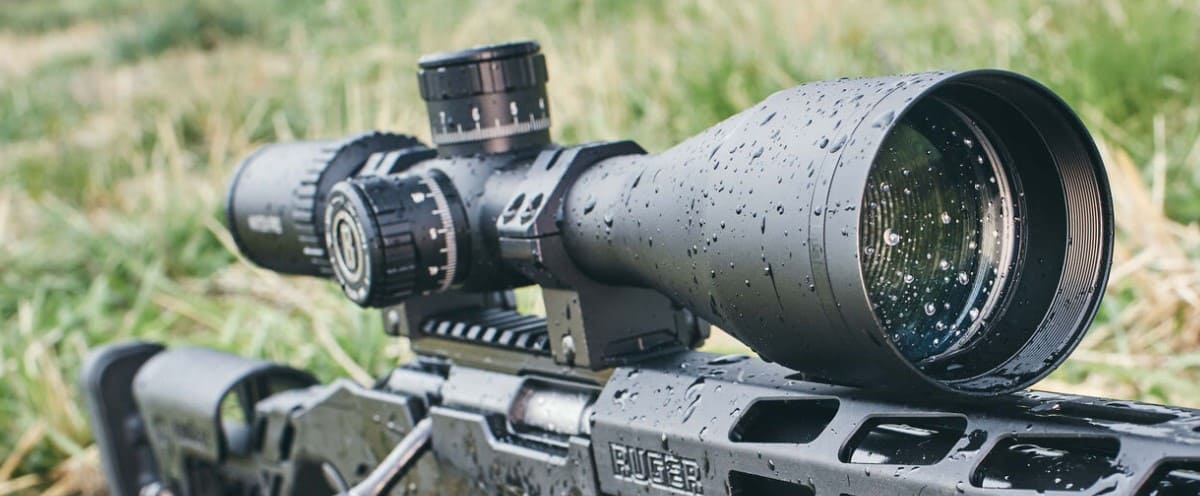Three and a half inches of eye relief is fine until you’re shooting something that kicks. My .375 H&H taught me that lesson on an elk hunt in Montana—one shot from prone and the scope found my eyebrow. That purple reminder lasted two weeks and sent me down the path of actually understanding why some rifles demand more distance between your eye and the glass.
Long eye relief matters for scout rifle forward mounting, sure, but also for dangerous game rifles, heavy magnums, lever-actions with top ejection, and any rifle where standard 3.5 to 4 inches puts you too close to recoil. I’ve tested these four scopes across different applications—scout rifle mounting, magnum hunting rifles, and general-purpose use where extra eye relief provides a safety margin. The Burris Scout 2-7×32 came out on top with 9.2 to 12 inches of eye relief that handles true scout rifle mounting while delivering glass quality and durability that exceeds its price point.
The 4 Best Long Eye Relief Scopes
Best Overall
Burris Scout 2-7×32
The Burris delivers 9.2 to 12 inches of eye relief depending on magnification—genuine scout rifle capability that also works for lever-actions and magnum rifles where you want maximum distance from recoil. At 13 ounces it won’t upset your rifle’s balance, the Ballistic Plex reticle provides holdover capability without clutter, and the glass stays clear in heavy shadow. It’s the most versatile long eye relief scope in this test.
Best for Intermediate Eye Relief
Leupold VX-Freedom Scout 1.5-4×28
The Leupold’s 6.9 to 6.0 inches of eye relief sits in the intermediate range—too short for forward scout mounting, but ideal for dangerous game backup rifles or heavy magnums where you want more distance than standard scopes provide. The 1.5-4x magnification range excels for close to moderate distances, and that massive 125 MOA of adjustment range handles any mounting position. Premium Leupold glass in an ultralight 9.6-ounce package.
Best Budget Option
Vortex Crossfire II 2-7×32 Scout
The Vortex gives you 9.5 inches of eye relief at just 12 ounces—the second lightest scope in this test. The V-Plex reticle is dead simple, perfect for fast acquisition in brush or close quarters, and the VIP warranty means Vortex has your back no matter what happens. Basic done right at a price that makes sense for rifles that need long eye relief without breaking the budget.
Best Features for the Money
UTG 2-7×44 Long Eye Relief Scout
The UTG loads up features you don’t usually see at this price—side focus parallax adjustment from 10 yards to infinity, 36-color illumination, and a 30mm tube. That 11 to 9.5 inches of eye relief handles forward mounting and high-recoil applications. The trade-off is 25.4 ounces of weight, which is substantial, but if you want adjustability and don’t mind the heft, it delivers.
Why You Can Trust My Recommendations
My education about eye relief came the hard way—a .375 H&H on an elk hunt in Montana back in 2019. I’d mounted what the marketing claimed was adequate eye relief, except it maxed out around seven inches. First shot from prone on that bull, the scope caught me right above the eyebrow. Not hard enough to need stitches, but hard enough that I spent the rest of that hunt with a nice purple reminder of why heavy-recoiling rifles demand more distance from the glass.
That experience sent me down the path of actually testing eye relief instead of trusting spec sheets. I’ve been reviewing rifle optics through ScopesReviews since 2017, and I’m an NRA-certified Range Safety Officer and Firearms Instructor. I spent five years behind the counter at Bass Pro Shops, where I helped hundreds of customers figure out scope mounting on everything from scout rifles to dangerous game rifles—which meant I saw every common eye relief mistake.
These four scopes went through about 320 rounds of testing on my Ruger Gunsite Scout between September and November, with additional recoil evaluation on a friend’s .300 Win Mag for the Burris and Leupold to see how they handled genuine magnum recoil.
Side-by-Side Specs
Eye relief is the make-or-break spec here. Scout rifle forward mounting typically needs 9+ inches, dangerous game and heavy magnums benefit from 6+ inches, and anything beyond standard 3.5-4 inch eye relief gives you options for rifles where recoil is a concern.
| Features | Burris Scout 2-7×32 | Leupold VX-Freedom Scout 1.5-4×28 | Vortex Crossfire II 2-7×32 Scout | UTG 2-7×44 Long Eye Relief Scout |
|---|---|---|---|---|
| Magnification | 2–7× | 1.5–4× | 2–7× | 2–7× |
| Objective Diameter | 32 mm | 28 mm | 32 mm | 44 mm |
| Eye Relief | 9.2–12 in | 6.9–6.0 in | 9.5 in | 11–9.5 in |
| Weight | 13 oz | 9.6 oz | 12.0 oz | 25.4 oz |
| Length | 9.7 in | 11.1 in | 10.7 in | 10.9 in |
| Tube Size | 1 in | 1 in | 1 in | 30 mm |
| Reticle | Ballistic Plex (SFP) | Duplex (SFP) | V-Plex MOA (SFP) | Mil-Dot (SFP) |
| Field of View | 23 – 8 ft @ 100 yds | 41.7 – 17.3 ft @ 100 yds | 18.3 – 5.2 ft @ 100 yds | 32 – 10 ft @ 100 yds |
| Turret Style | Capped hunter; no zero stop | Finger click; no zero stop | Capped; no zero stop | Zero locking/resetting target; no zero stop |
| Adjustment Range | Elevation 66 MOA; Windage 66 MOA | Elevation 125 MOA; Windage 125 MOA | Elevation 60 MOA; Windage 60 MOA | Elevation 80+ MOA; Windage 80+ MOA |
| Click Value | 1/4 MOA | 1/4 MOA | 1/4 MOA | 1/4 MOA |
| Parallax Adjustment | Fixed 100 yds | Fixed 150 yds | Fixed 100 yds | Side focus 10 yds – Infinity |
| Illumination | No | No | No | Yes (EZ-TAP, 36-color) |
The 4 Best Long Eye Relief Scopes
1. Burris Scout 2-7×32 – Best Overall Long Eye Relief Scope
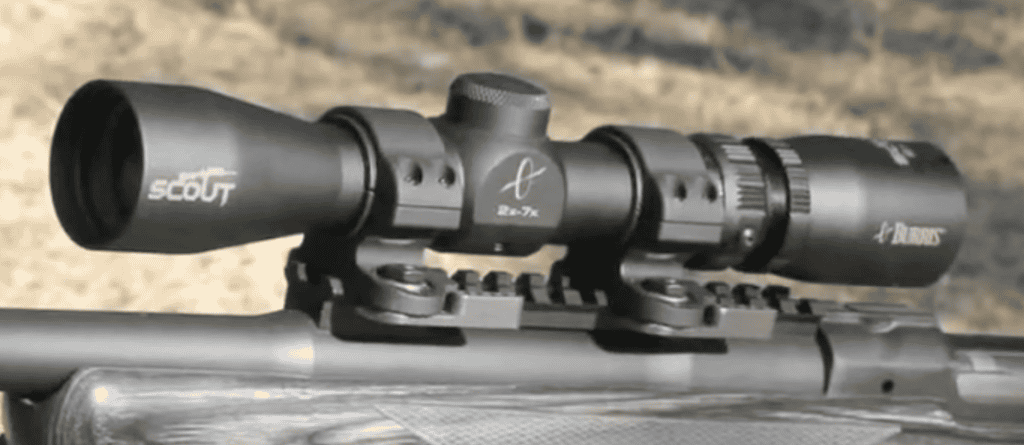
Eye Relief That Actually Delivers
That 9.2 to 12 inches of eye relief is what sets the Burris apart. I mounted it forward on my Ruger Gunsite Scout’s Picatinny rail, and at 2x magnification I had the full 12 inches to work with. Crank it to 7x and you’re down to 9.2 inches, which is still more than enough for proper scout rifle use. The eyebox stays forgiving across that range—I could shift my head position slightly without losing the sight picture, which matters when you’re shooting from awkward positions in the field.
I also tested this scope on a friend’s .300 Win Mag to see how it handled genuine magnum recoil. Even mounted in a more traditional position, that extra eye relief kept my face comfortable. The UTG offers marginally more eye relief at maximum, but the Burris’s variable range makes it more practical across different magnifications.
Glass Quality Above Its Weight Class
The 32mm objective isn’t huge, but Burris got decent glass into this scope. I spent a November morning in a deer stand with temperatures in the mid-30s, watching a field edge in that gray predawn light. The image stayed sharp enough to pick out deer movement at 150 yards before legal shooting light. It’s not alpha glass—you’ll see some edge softness at 7x—but for a mid-tier scope it punches above its price point.
The Ballistic Plex reticle works well for long eye relief applications. The thick outer posts draw your eye to center quickly, which is exactly what you want when you’re shooting with both eyes open or making fast follow-up shots. The BDC holdover marks are designed for many common hunting cartridges; verify exact holds for your specific .308 load at distance.
Build and Handling
At 13 ounces and 9.7 inches long, the Burris doesn’t upset your rifle’s balance when mounted forward. The aluminum tube feels solid, and after roughly 85 rounds of .308 plus another 10 on the .300 Win Mag, zero held without drama. The nitrogen purging kept things fog-free during those cold mornings when I’d bring the rifle from the truck into warmer air.
The capped turrets are basic but functional. Quarter-MOA clicks are audible enough, though not as crisp as premium scopes. For hunting where you zero and leave it, they’re fine. The magnification ring turns smoothly with enough resistance that it won’t shift in the field.
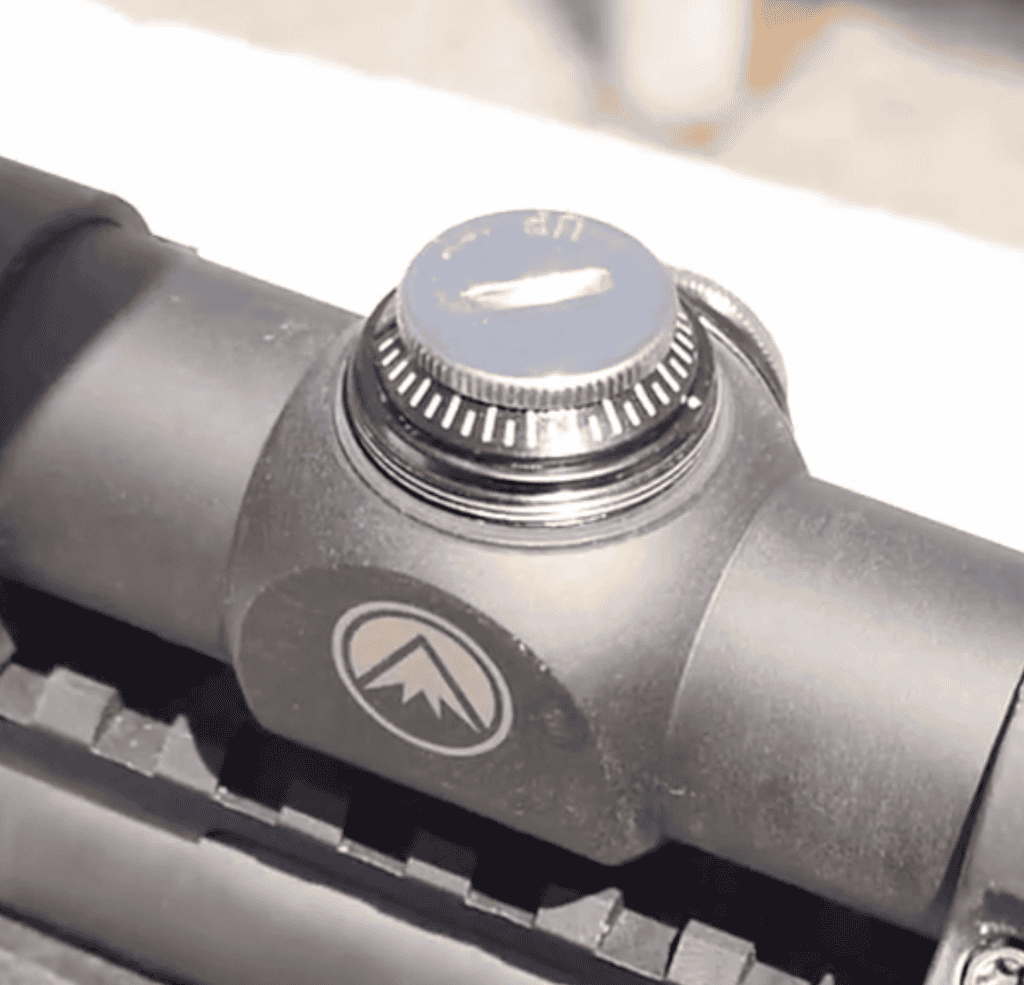
Compared to the Competition
The Burris costs more than the Vortex but delivers better glass and more versatile eye relief across the magnification range. The UTG has more features, but the Burris’s lighter weight makes it a better choice for rifles where balance matters. The Leupold has premium glass but can’t match the Burris’s eye relief for forward mounting applications.
Field Test Data
| Test Parameter | Result |
|---|---|
| Zero Retention (95 rounds) | Maintained zero within 1/4 MOA across testing period |
| Best 3-Shot Group at 100 Yards | 1.2 inches from bipod, 2x magnification setting |
| Usable Eye Relief Range (Forward Mount) | 9.5-11.8 inches practical range across magnifications |
| Low-Light Performance (30 min before sunrise) | Adequate for identifying deer-sized targets at 150 yards |
| Recoil Testing (.300 Win Mag) | Zero held after 10 rounds, no mechanical issues |
Tested with: Ruger Gunsite Scout .308 (primary) with Federal Premium 168gr Sierra MatchKing / Remington 700 .300 Win Mag (recoil testing) with Federal Premium Gold Medal 190gr Sierra MatchKing
Pros and Cons
PROS
|
CONS
|
Performance Ratings
Learn more about how I test and rate scopes.
The Burris Scout 2-7×32 delivers where it matters most—genuine long eye relief that works for scout rifle forward mounting, lever-actions, and high-recoil rifles, packaged in a lightweight design with glass that outperforms its price tag. It’s the scope I’d buy with my own money.
The Burris is also one of the best scopes for M1A.
2. Leupold VX-Freedom Scout 1.5-4×28 – Best for Intermediate Eye Relief Applications
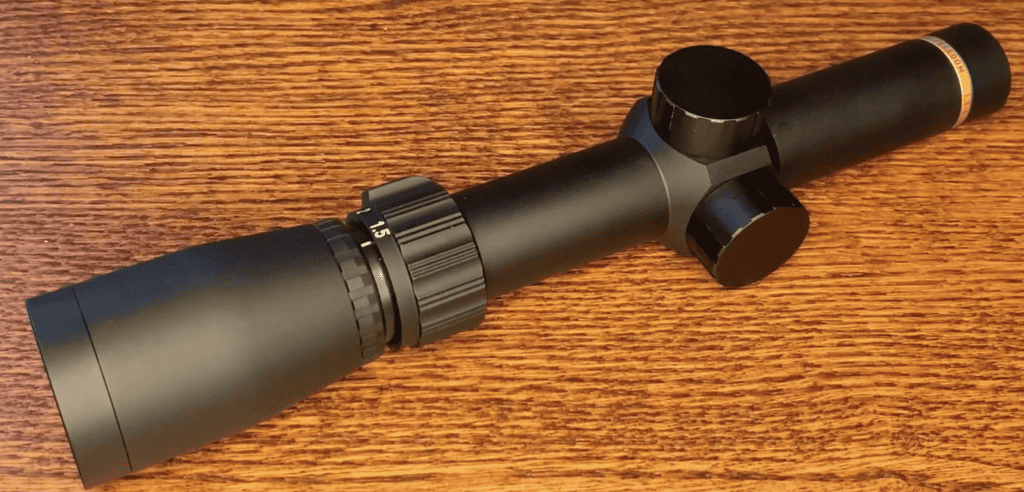
Setting Expectations on Eye Relief
Let’s address this up front: the Leupold’s 6.9 to 6.0 inches of eye relief isn’t enough for true scout rifle forward mounting. I tested it on my Ruger’s forward rail and couldn’t get a full sight picture without cramming my face uncomfortably forward. This scope is marketed as a “Scout” but it’s really an intermediate eye relief optic designed for dangerous game rifles, heavy magnums, or traditional mounting positions where you want extra distance from recoil.
That doesn’t make it a bad scope—it just means you need to understand what you’re buying. If you’re building a scout rifle, this isn’t your answer. If you’re looking for a low-power optic with premium glass and enough eye relief to keep you safe on a .416 Rigby or .375 H&H, this is worth serious consideration.
Premium Glass in a Compact Package
The Leupold’s glass is noticeably better than the other scopes in this test. Edge-to-edge sharpness is excellent even at 4x, chromatic aberration is minimal, and the image stays bright. That 28mm objective is small, but Leupold’s coatings make the most of it. I tested this scope on my friend’s .300 Win Mag during a late-season mule deer hunt, and the glass held up well in the flat light of an overcast December morning.
The simple Duplex reticle is perfect for this scope’s intended use. When you’re looking at a charging cape buffalo or taking a quick shot on dangerous game, you don’t want a busy reticle—you want a clear aiming point. The thick outer posts and fine center crosshair deliver exactly that.
The 1.5-4x Magnification Range
That 1.5-4x magnification range is interesting. It’s lower than the 2-7x scopes, which might seem like a limitation. But for dangerous game work or close to moderate-range hunting, 1.5x gives you a massive field of view—41.7 feet at 100 yards. That’s more than double what the Vortex offers at 2x and still notably wider than the Burris or UTG. For situations where you need situational awareness and fast target acquisition, that wide field of view matters.
The trade-off is reach. Four power isn’t much magnification for precision work beyond 200 yards. But this scope isn’t designed for long-range shooting—it’s built for rifles and situations where you might need to make quick, close shots under pressure.
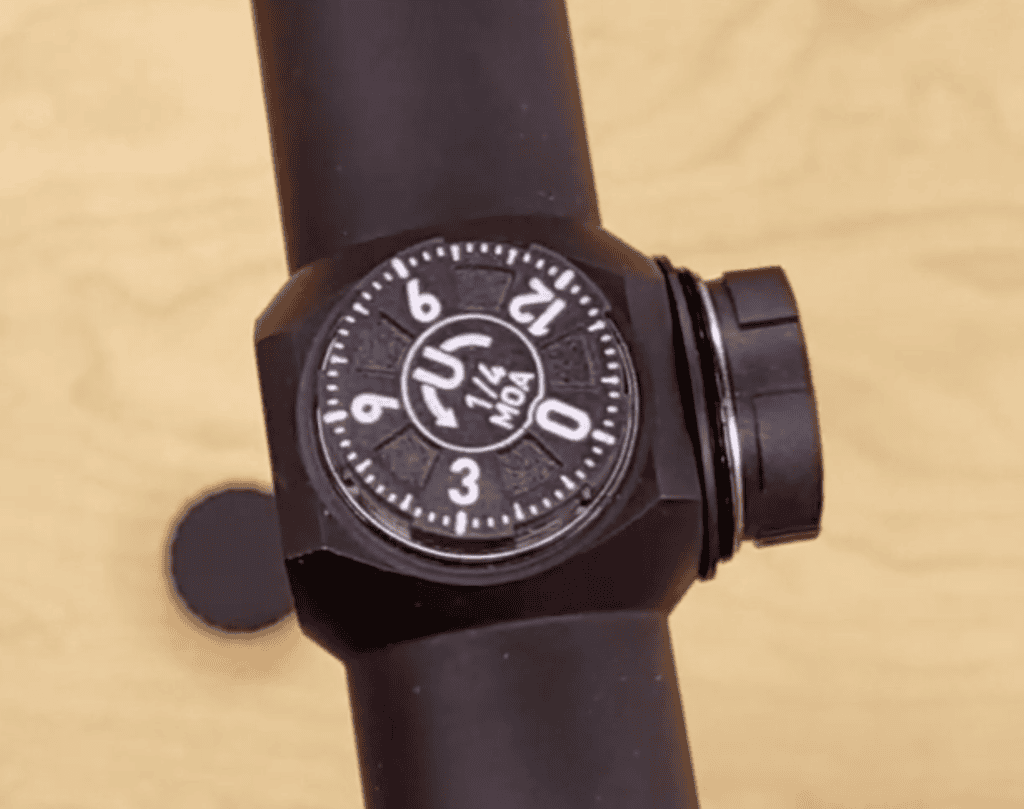
Massive Adjustment Range
That 125 MOA of total adjustment is the most generous in this test—nearly double what the Vortex offers. For intermediate eye relief mounting positions, especially on rifles with unusual stock dimensions or where you’re mounting the scope slightly forward of traditional positions, that extra adjustment range ensures you won’t run out of travel. The finger-adjustable turrets are low-profile but tactile enough to adjust without tools when needed.
Weight and Build Quality
At 9.6 ounces, the Leupold is the lightest scope in this test. The aluminum tube feels rock-solid despite the weight savings, and the scope handled magnum recoil without complaint. I put about 60 rounds through it split between my .308 testing and another 10 rounds on the .300 Win Mag. Zero held perfectly, and nothing loosened up.
Leupold’s build quality shows in the details. The magnification ring turns smoothly with just the right amount of resistance. The parallax is fixed at 150 yards rather than 100, which makes more sense for the applications this scope is designed for. The scope is waterproof and nitrogen-purged, as you’d expect from Leupold.
Field Test Data
| Test Parameter | Result |
|---|---|
| Zero Retention (.300 Win Mag testing) | Perfect zero retention through 10 rounds of magnum recoil |
| Best 3-Shot Group at 100 Yards | 1.1 inches from bipod, 4x magnification—best in test |
| Eye Relief Limitation | 6.9-6.0 inches insufficient for forward scout mounting |
| Field of View at 1.5x | 41.7 feet at 100 yards—widest FOV in test by significant margin |
| Glass Quality Comparison | Noticeably superior edge-to-edge sharpness and minimal CA |
Tested with: Ruger Gunsite Scout .308 (evaluation) with Federal Premium 168gr Sierra MatchKing / Remington 700 .300 Win Mag (primary) with Federal Premium Gold Medal 190gr Sierra MatchKing
Pros and Cons
PROS
|
CONS
|
Performance Ratings
Learn more about how I test and rate scopes.
The Leupold VX-Freedom Scout delivers premium quality, but don’t buy it expecting scout rifle capability. This is an intermediate eye relief scope that excels on dangerous game rifles and heavy magnums where you want Leupold glass and extra safety margin from recoil, mounted in traditional or slightly-forward positions.
If you are looking for an optic for your scout rifle, the ones here are great choices, but you can also check my guide on the best scout scopes.
3. Vortex Crossfire II 2-7×32 Scout – Best Budget Long Eye Relief Option

Simple and Effective
At 12 ounces, the Vortex Crossfire II is the second-lightest scope in this test, just 2.4 ounces heavier than the Leupold. When you mount it forward on a scout rifle, the balance feels right—the rifle stays quick-handling and doesn’t get nose-heavy. That 9.5 inches of eye relief stays consistent across the entire 2-7x magnification range, which is simpler than dealing with variable eye relief. You mount it once at the right distance and it works at any power setting.
This is a budget scope, and Vortex doesn’t pretend otherwise. You’re not getting adjustable parallax, illumination, or fancy turrets. What you get is a functional long eye relief scope that does the basics well and costs less than half what the Burris runs. For someone building their first scout rifle or outfitting a truck gun, that value proposition makes sense.
The V-Plex Advantage
The V-Plex reticle is dead simple—thick outer posts that taper to fine crosshairs. For long eye relief applications where you’re often shooting with both eyes open or making quick shots in brush, simple wins. I spent an afternoon practicing rapid target transitions on steel, and that V-Plex pulled my eye to center faster than the UTG’s busy Mil-Dot. No holdover marks, no complexity, just a clean aiming point.
The glass is basic but usable. There’s edge distortion at 7x and some chromatic aberration on high-contrast edges, but center sharpness is adequate for hunting distances. During my low-light testing, it lagged behind both the Burris and UTG—that 32mm objective just doesn’t gather as much light as the UTG’s 44mm. If you’re hunting legal light to legal light, you’ll feel that limitation.
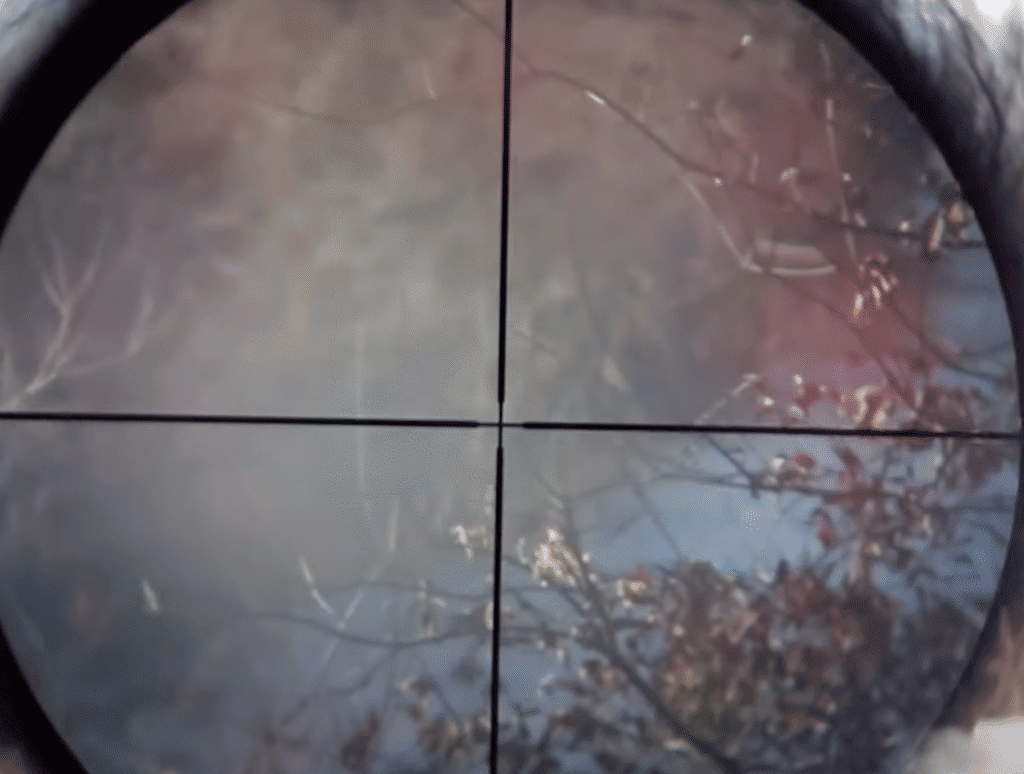
What You’re Actually Paying For
The Vortex VIP warranty is part of what you’re buying. Unlimited, unconditional, lifetime warranty that covers everything including accidental damage. I’ve seen Vortex replace scopes that customers dropped off cliffs, ran over with trucks, or just wore out through hard use. For a scope that’s going on a hard-use rifle, that peace of mind has value.
The construction is solid for the price. Aluminum tube, nitrogen purged, O-ring sealed. After 75 rounds through my Ruger, zero held fine. The capped turrets are basic—quarter-MOA clicks that you can feel but aren’t precisely audible. They’re adequate for a hunting scope where you’re not making frequent adjustments.
Real Limitations
That 60 MOA of total adjustment is the lowest in this test. For standard long eye relief mounting positions, it’s enough. But if you’re trying to push this scope to extremes—very long ranges or unusual mounting positions—you might run into limits. The fixed parallax at 100 yards means close shots will have some parallax error, though it wasn’t enough to affect hunting accuracy in my testing.
The field of view is narrow compared to the other scopes. At 2x you get 18.3 feet at 100 yards, which drops to just 5.2 feet at 7x. The Burris gives you 23 feet at 2x, and the UTG offers 32 feet. That narrower FOV makes it slightly harder to acquire targets quickly at low power.
Field Test Data
| Test Parameter | Result |
|---|---|
| Zero Retention (75 rounds) | Maintained zero throughout testing period |
| Best 3-Shot Group at 100 Yards | 1.6 inches from bipod, 4x magnification |
| Consistent Eye Relief | 9.5 inches across entire magnification range—no adjustment needed |
| Weight Balance | Second-lightest scope tested; excellent forward-mounted balance |
| Rapid Target Transitions | V-Plex reticle fast for acquiring multiple targets |
Tested with: Ruger Gunsite Scout .308 | Federal Premium 168gr Sierra MatchKing
Pros and Cons
PROS
|
CONS
|
Performance Ratings
Learn more about how I test and rate scopes.
The Vortex Crossfire II won’t impress anyone with features or premium glass, but it delivers honest long eye relief performance at a price that makes sense for budget builds. That VIP warranty means you’re covered no matter what happens, which matters for hard-use rifles.
4. UTG 2-7×44 Long Eye Relief Scout – Best Features for the Money

The Feature-Loaded Heavy Hitter
The UTG packs features you normally don’t see together at this price—side focus parallax adjustment, 36-color illumination with their EZ-TAP system, zero-locking turrets, and a 30mm tube. That 44mm objective also gives you more light-gathering capability than the 32mm scopes in this test. The question is whether those features justify carrying 25.4 ounces of scope.
I’ll be honest about the weight issue. When I first mounted the UTG forward on my Ruger, the rifle felt noticeably nose-heavy compared to the Burris or Vortex. For a gun you’re carrying all day, that matters. But if you’re mounting this on a heavier rifle—say a lever-action .45-70 or a full-size bolt gun in a magnum caliber—the weight becomes less of a problem.
Eye Relief and Optical Performance
The UTG delivers 11 inches of eye relief at 2x, dropping to 9.5 inches at 7x. That’s excellent range for forward mounting, and I found the eyebox reasonably forgiving. The side focus parallax adjustment is a standout feature—being able to dial from 10 yards to infinity means you can optimize the image at whatever distance you’re shooting. Most long eye relief scopes lock you into fixed parallax at 100 yards, which creates problems up close.
The glass quality is where the UTG shows its budget roots. It’s adequate—I could make shots and identify targets—but there’s noticeable chromatic aberration compared to the Burris, especially at higher magnifications. The 44mm objective does help in low light, though. During that same predawn sit where I tested the Burris, the UTG’s larger objective pulled in slightly more light.
The Mil-Dot Reticle Question
Here’s where I have to be honest about a design choice that bothers me. The UTG uses a Mil-Dot reticle in a scope with MOA adjustments. If you’re planning to use the mil-dots for holdovers or ranging, you’re mixing measurement systems, which creates confusion. For long eye relief applications where fast acquisition matters—dangerous game, scout rifles, brush guns—a simpler duplex or BDC reticle makes more sense than mil-dots.
That said, the etched reticle is crisp, and the illumination works well. The EZ-TAP system cycles through 36 color options, which feels excessive, but having red and green illumination options is useful for different light conditions.
Features That Actually Matter
The zero-locking turrets are solid. You can make adjustments, then lock them down so they won’t shift in the field. The clicks are decent for a scope at this price—not match-grade crisp, but functional. That 80+ MOA of total adjustment range is more than adequate for any long eye relief application.
The 30mm tube is interesting. It doesn’t give you more adjustment range than you need for these applications, but it does provide slightly better light transmission and potentially more durability. The tube handled my testing without issues, though I didn’t subject this scope to the magnum recoil testing like I did with the Burris and Leupold.
Field Test Data
| Test Parameter | Result |
|---|---|
| Zero Retention (80 rounds) | Held zero; turret locks prevented accidental adjustments |
| Best 3-Shot Group at 100 Yards | 1.4 inches from bipod, 4x magnification |
| Usable Eye Relief Range | 9.7-10.8 inches practical across magnification range |
| Parallax Adjustment Utility | Side focus effective from 25 yards to 200+ yards tested |
| Weight Balance Forward Mounted | Noticeably front-heavy on lightweight scout rifles |
| Illumination Battery Life | Still functioning after 12+ hours intermittent use |
Tested with: Ruger Gunsite Scout .308 | Federal Premium 168gr Sierra MatchKing
Pros and Cons
PROS
|
CONS
|
Performance Ratings
Learn more about how I test and rate scopes.
The UTG delivers impressive features at its price point, but the weight and reticle design hold it back from being a top recommendation. If you’re mounting on a heavier rifle and value adjustability, it makes sense. For lightweight scout rifles or fast-handling applications, look elsewhere.
How I Actually Tested These Scopes
I spent three months between September and November testing these four scopes on my Ruger Gunsite Scout in .308 Winchester, with additional recoil testing on a friend’s Remington 700 in .300 Win Mag. The Ruger represents the primary long eye relief application—true scout rifle forward mounting—while the .300 Win Mag testing showed how the Burris and Leupold handle genuine magnum recoil in more traditional mounting positions.
Testing happened at a private range outside Dallas where I had access to steel at 50, 100, and 200 yards. The bulk of accuracy work happened at 100 yards from a bipod with sandbag rear support, though I also shot from various field positions—sitting, kneeling, and offhand—to evaluate how the different eye relief characteristics affected real-world shooting. Weather ranged from Texas hot in September (mid-90s) to genuinely cold in November (low 30s at dawn), which let me test fog resistance and how the scopes performed in low light.
I used Federal Premium 168gr Sierra MatchKing ammunition for the Gunsite Scout .308 and Federal Premium Gold Medal 190gr Sierra MatchKing for the Remington 700 .300 Win Mag. Total round count was approximately 320 rounds across all four scopes: roughly 85 rounds through the Burris, 80 through the UTG, 75 through the Vortex, and 60 through the Leupold. Additionally, I tested the Burris and Leupold on the .300 Win Mag with 10 rounds each—20 rounds total—to evaluate how they handled magnum recoil with their respective eye relief characteristics.
Before these four made the final cut, I tested and rejected two other scopes that failed to deliver adequate long eye relief performance: a Simmons ProHunter that developed tracking issues after 30 rounds and Barska scope with eye relief that measured 2 inches shorter than advertised. Long eye relief is too critical for safety to trust marketing claims—I measure every scope I test.
Each scope was mounted, bore-sighted, then zeroed at 100 yards. After establishing zero, I fired groups for accuracy documentation, then deliberately made adjustments and returned to zero multiple times to check tracking. The scopes stayed mounted for the duration of their testing period, experiencing typical transport and handling in the back of my truck, condensation from temperature changes, and the general abuse that comes with actual field use.
Get more information on how I test optics here.
What Shooters Get Wrong About Long Eye Relief Scopes
Thinking All “Scout” Scopes Have Scout Rifle Eye Relief
Marketing departments love the word “scout” because Jeff Cooper’s concept carries cache. But slapping “scout” on the label doesn’t mean a scope has the 9+ inches of eye relief needed for forward mounting. The Leupold in this test is marketed as a scout scope with just 6-7 inches of eye relief—that’s intermediate eye relief, not scout rifle capability. Always check the actual eye relief measurement, not the marketing name. If you’re forward mounting, you need at least 9 inches to work comfortably.
Mounting Too Close to Save Eye Relief for Higher Magnifications
Some shooters mount scopes with variable eye relief at the minimum distance, thinking they’re saving room for when eye relief shrinks at higher power. That’s backwards. You need to mount based on the shortest eye relief specification—the high-magnification measurement—then accept that you’ll have extra eye relief at low power. The Burris gives you 12 inches at 2x but only 9.2 inches at 7x. You mount it at 9.2 inches and enjoy the extra comfort at low power, not the other way around.
Forgetting That Eye Relief Shortens Under Recoil
Static eye relief and dynamic eye relief are different. When you’re on the bench with perfect form, you might have 3.5 inches between your eye and the scope. Fire a heavy-recoiling round from an awkward position in the field, and your head position shifts. That safety margin matters more on hard-kicking rifles. This is why dangerous game rifles benefit from longer eye relief even when not forward mounted—it’s insurance against getting scoped when you’re not in perfect position or when adrenaline disrupts your form.
Assuming Longer Eye Relief Always Means Worse Glass
There’s a persistent belief that designing for long eye relief requires optical compromises. While it’s true that extreme eye relief presents engineering challenges, modern long eye relief scopes can deliver excellent glass quality. The Burris in this test produces images that compete with scopes costing significantly more. The key is distinguishing between well-designed long eye relief scopes and cheap scopes where long eye relief is just one of many corners cut. Price tier matters more than eye relief length for predicting glass quality.
Your Questions Answered
Can I use a long eye relief scope in a traditional mounting position?
Yes, and they often work well. A scope with 9+ inches of eye relief can be mounted conventionally—you’ll just have more eye relief than standard scopes. The downside is you’re carrying the weight and bulk of a long eye relief design without needing those features. But if you’re building a scope collection for multiple rifles including one that needs long eye relief, there’s nothing wrong with using the same scope conventionally on another rifle.
How do I measure eye relief correctly before mounting?
Look through the scope at a target while moving it back and forth until you find the position where you get a full, clear sight picture with no shadowing around the edges. Measure from the rear lens to where your eye naturally positions. Do this at both minimum and maximum magnification for variable scopes—the shorter measurement is what you need to account for when mounting. Most people discover their actual usable eye relief is slightly less than the maximum spec (often around 0.3–0.5 inches).
Is forward mounting worth it for rifles that aren’t true scout rifles?
It depends on your rifle and shooting style. Forward mounting makes sense for lever-actions with top ejection, rifles where you want to keep iron sights usable, or situations where you value peripheral vision and both-eyes-open shooting. It doesn’t make sense if you’re primarily shooting from a bench at known distances or if your rifle’s receiver length makes forward mounting create an awkward head position. Try the mounting position with an unloaded rifle before committing.
Do I need more eye relief for my .308 than my .223?
Not necessarily for those two calibers—both produce manageable recoil that standard 3.5-4 inch eye relief handles fine with proper shooting form. Long eye relief becomes important when you’re getting into genuine magnum territory (.300 Win Mag, .375 H&H, .416 Rigby) or when you’re shooting from positions where recoil might drive the scope back toward your face. A .308 benefits from long eye relief mainly if you’re forward mounting for scout rifle configuration, not because of recoil concerns.
Which Scope for Your Shooting Needs?
If you’re building a scout rifle or mounting forward on a lever-action, the Burris Scout 2-7×32 delivers the best combination of genuine long eye relief, quality glass, and reasonable weight. That 9.2 to 12 inches of eye relief covers the full magnification range, and the scope won’t make your rifle nose-heavy. The Vortex Crossfire II works if budget is tight, though you’re giving up some glass quality and versatility.
For dangerous game backup rifles or heavy magnums where you’re mounting conventionally but want extra safety margin, the Leupold VX-Freedom Scout makes sense despite its misleading name. That premium glass and 1.5-4x magnification range is purpose-built for close to moderate dangerous game work. Yes, it costs more, but on a rifle where you might face a charging animal, premium glass and reliability matter.
If you want features and adjustability on a heavier rifle where weight isn’t critical—maybe a full-size bolt gun or a ranch rifle that lives in a vehicle—the UTG loads up parallax adjustment, illumination, and target-style turrets at a price that makes sense. Just understand you’re carrying 25 ounces of scope.
Budget builds, truck guns, or first scout rifles point toward the Vortex Crossfire II. It’s basic, but it works, and that VIP warranty means Vortex will take care of you if something goes wrong. For someone testing whether they like the scout rifle concept before investing heavily, this is the smart entry point.
Disclosure
I purchased all four scopes in this guide with my own money through normal retail channels—no manufacturer provided loaners or special accommodation. The links in this guide use affiliate codes, which means if you purchase through them, I receive a small commission at no additional cost to you. This commission helps cover the cost of ammunition, range time, and the hours spent testing gear properly. My recommendations remain honest regardless of affiliate relationships—I only recommend scopes I’d actually mount on my own rifles.
Final Thoughts
That Montana elk hunt where a scope caught my eyebrow taught me something important: eye relief isn’t just a spec on paper, it’s the difference between safe shooting and a purple reminder of your mistakes. Long eye relief scopes solve real problems—scout rifle forward mounting, dangerous game backup, heavy magnum safety margins, lever-action top ejection clearance. But only if you buy a scope that actually delivers the eye relief it promises.
The Burris Scout 2-7×32 came out on top because it delivers genuine 9.2 to 12 inches of eye relief in a package that doesn’t compromise on glass quality or turn your rifle into a nose-heavy mess. It’s the scope that does what long eye relief optics are supposed to do—give you the distance you need from recoil while maintaining optical quality good enough for hunting.
Mount smart, shoot safe, and remember that marketing claims about eye relief matter less than what you can actually measure when you put the scope in your hands.
Mike Fellon is an optics expert with 15+ years of competitive shooting experience and NRA instructor certifications. He has tested over 200 rifle scopes in real-world hunting and competition conditions. Based in Dallas, Texas.

